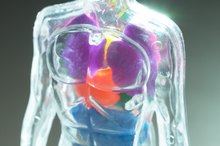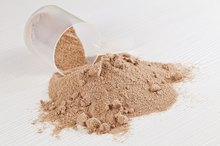Calcium & Blood Clotting
Your body uses calcium not only to keep teeth and bones strong, but also to enable muscles to contract, to assist in the transmission of neural impulses and to maintain cell membrane stability and permeability. It is also an important part of the blood clotting process and because your body is unable to generate calcium, it is important that you have adequate daily intake.
The Clotting Process
Whenever your skin becomes broken, the sticky platelets contained in the blood form clots to stop blood flow. Calcium works together with vitamin K and a protein called fibrinogen in the clotting cascade. Without adequate levels of calcium and vitamin K, blood will take longer to clot, and if both nutrients are missing you might bleed to death. Most people gain enough calcium and vitamin K from their diets, but in some cases supplements may be prescribed.
- Whenever your skin becomes broken, the sticky platelets contained in the blood form clots to stop blood flow.
- Without adequate levels of calcium and vitamin K, blood will take longer to clot, and if both nutrients are missing you might bleed to death.
The Clotting Cascade
Calcium's Effects on the Nervous System
Learn More
As soon as blood from a wound is exposed to the air, the platelets disintegrate and react with fibrinogen to create fibrin: a mass of tiny threads. This triggers a whole series of reactions that rely on adequate levels of calcium and vitamin K to work. The fibrin hardens very quickly to form a scab over the wound.
Foods that Contain Calcium
Low-fat dairy products such as milk, yogurt and cheese contain a lot of calcium, and you will also find calcium in dried beans, tofu, spinach, broccoli and dark green vegetables. Certain cereals, vegan dairy substitutes and juices may be fortified with it. You must get an adequate daily intake of vitamin D to assist your body's absorption of calcium, so make sure that if you take calcium supplements, they contain vitamin D as well.
Recommended Intake
What Are the Daily Values of Calcium for a 2000 Calorie Diet?
Learn More
Adults under the age of 50 need around 1,000 mg calcium each day while older adults need around 1,200 mg each day. Children and adolescents need a higher intake of calcium because they grow rapidly. Those under 10 should get around 400 to 800 mg each day and those aged 11 to 24 need around 1,200 to 1,500 mg every day.
Do I Need Extra Calcium?
Most people gain enough calcium by eating a healthy and varied diet, but those at risk include menopausal women who may be at risk of rapid bone loss, vegetarians and those who are lactose intolerant because they may not be getting enough calcium from their diets. If you feel that you may be at risk contact your family physician.
Meeting Your Calcium Needs
If you have been told that you need to increase your calcium intake, try using low-fat or fat-free milk to make mashed potatoes, puddings and smoothies. Add low-fat or fat-free cheese to meals or try calcium-fortified tofu with fried vegetables or meat. Include other calcium-fortified foods such as cereals and drinks in your diet.
Related Articles
References
- Nursing Times: Maintaining Calcium Balance: Physiology and Implications
- Family Doctor: Calcium: What You Need to Know
- Bolland, MJ, et. al. Calcium supplements with or without vitamin D and risk of cardiovascular events: reanalysis of the Women's Health Initiative limited access dataset and meta-analysis. BMJ. 2011 Apr 19;342:d2040. DOI: 10.1136/bmj.d2040
- Reid IR. The roles of calcium and vitamin D in the prevention of osteoporosis. Endocrinol Metab Clin North Am. 27: 389-398. DOI:10.1016/s0889-8529(05)70011-6
- Chen M, Pan A, Malik VS, Hu FB. Effects of dairy intake on body weight and fat: a meta-analysis of randomized controlled trials. The American Journal of Clinical Nutrition. 2012;96(4):735-747. DOI:10.3945/ajcn.112.037119
- Williams V, Rawat A, Vignesh P, Shandilya JK, Gupta A, Singh S. Fc-gamma receptor expression profile in a North-Indian cohort of pediatric-onset systemic lupus erythematosus: An observational study. Int J Rheum Dis. 2019;22(3):449-457. doi: 10.6061/clinics/2012(07)22
- Reid IR, Birstow SM, Bolland MJ. Calcium and Cardiovascular Disease. Endocrinol Metab (Seoul). 2017;32(3):339-349. doi: 10.3803/EnM.2017.32.3.339
- MedlinePlus Medical Encyclopedia, "Milk-alkali syndrome"
- Bolland MJ, Grey A, Avenell A, Gamble GD, Reid IR. Calcium supplements with or without vitamin D and risk of cardiovascular events: reanalysis of the Women’s Health Initiative limited access dataset and meta-analysis. BMJ. d2040-d2040. DOI:10.1136/bmj.d2040
- Chan Soo Shin, et. al. Endocrinol Metab (Seoul). 30(1): 27–34. DOI: 10.3803/EnM.2015.30.1.27
- Linus Pauling Institute. Calcium.
- National Institute of Health Office of Dietary Supplements. Calcium.
- Weingarten MAMA, Zalmanovici Trestioreanu A, Yaphe J. Dietary calcium supplementation for preventing colorectal cancer and adenomatous polyps. Cochrane Database of Systematic Reviews 2008, Issue 1. Art. No.: CD003548. DOI: 10.1002/14651858.CD003548.pub4
- Zemel, MB et. al. Calcium and dairy acceleration of weight and fat loss during energy restriction in obese adults. Obes Res. 2004 Apr;12(4):582-90. DOI: 10.1038/oby.2004.67
Writer Bio
Laura Parr began her professional writing career in 2008 contributing to websites such as Travelbox, 1stop and Traveldojo. She now writes health and fitness-related articles. Parr earned a diploma of adult nursing from the University of Brighton, followed by a postgraduate certificate in public health from the University of Manchester.









